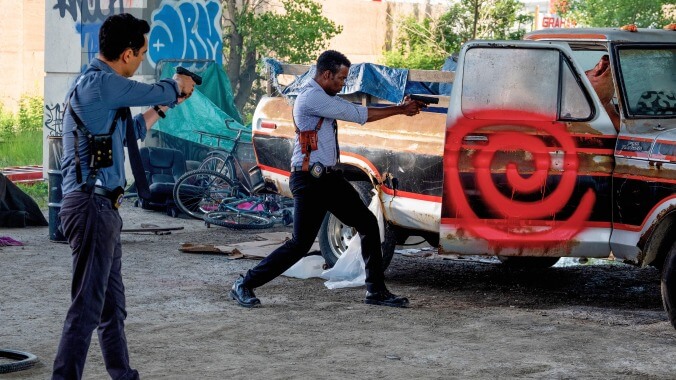Chris Rock brings some fresh blood to the late-stage sequel Spiral: From The Book Of Saw

Note: The writer of this review watched Spiral: From The Book Of Saw in a sparsely attended press screening with intensive social-distancing precautions. Before making the decision to see it—or any other film—in a movie theater, please consider the health risks involved. Here is an interview on the matter with scientific experts.
Some might accuse Spiral: From The Book Of Saw of kowtowing to liberal cancel culture. But for all its reveling in sadistic Rube Goldberg devices and nü-metal aesthetics, Saw does have a moral compass—one of a teenager doodling their teachers being impaled on spikes and coated in boiling oil in the margins of a chemistry textbook, but a moral compass nonetheless. This isn’t the first time the series has tackled police brutality; crooked cops have been unwittingly recruited into Jigsaw’s twisted “games” since Saw II. But Spiral, the ninth entry into this nearly 20-year-old franchise, makes “ACAB” its rallying cry. Well, sort of. It gets convoluted. Things often do in a Saw movie.
Chris Rock stars as Detective Zeke Banks, the lone good apple in a rotten barrel who became persona non grata at the Metropolitan Police Department after reporting a fellow officer for murdering a civilian. (In perhaps this film’s most unbelievable twist, the cop served nine years for the crime.) Despite being the son of former police chief Marcus Banks (Samuel L. Jackson), Zeke is now an outsider, and it’s made him bitter, mistrustful, and short-tempered. His boss, Captain Angie Garza (Marisol Nichols), still believes in him, however, and puts Zeke and his rookie partner, William Schenk (Max Minghella), in charge of the case when the poor sucker who has his tongue ripped out before being hit by a train in the opening sequence—the guy is played by Canadian actor Dan Petronijevic, a.k.a. Letterkenny’s McMurray—turns out to be one of Zeke’s few friends on the force.
Add in a couple of diabolical appliances and a bloody USB drive hand-delivered to Zeke’s desk, and it becomes very clear that there’s a serial killer out there punishing police officers for their abuses of power. The modus operandi is, of course, strikingly similar to that of deceased criminal mastermind John Kramer, a.k.a. Jigsaw, as one character notes after everyone gathers around to watch the fiend’s first video message to the MPD. But that’s about as far as Spiral’s connection to the previous sequels goes. While it does have thematic ties to those films, Spiral is a standalone story with new characters; even the murder puppet is different this time around, with a grotesque marionette pig standing in for fans’ beloved Billy. Unlike Saw 2, however, Spiral was conceived as a Saw movie from the jump. In fact, it was Rock who came to Lionsgate with an idea for the film, eventually serving as a producer as well as the star.
Rock may be a fan of the franchise, but director Darren Lynn Bousman (Repo! The Genetic Opera; Saws II, III, and IV) seems especially tickled to be working with Jackson, slipping in several nods to his star-making turn in Pulp Fiction. The first and best of these is the Tarantino-esque monologue about Forrest Gump Rock delivers at the beginning of the movie; it’s actually pretty hilarious, although the refreshing comedic tone established in those early scenes unfortunately doesn’t last. Before long, we’re back to po-faced grit, as Grand Guignol experiments in mousetrap mindfuckery unfold in environments like a raw industrial loft, a grimy industrial warehouse, and a filthy industrial recycling center.
Those graffiti-covered portals to Hell play host to the real reason the Saw franchise still exists: the torture scenes. These seem to be applying a “back to basics” approach along the lines of the 2018 Halloween, downsizing from the elaborate “game” played in 2017’s Jigsaw into more streamlined—and, one might argue, more elegant—pain delivery systems. What is not toned down is the visceral horror of watching blood gush from ragged wounds and humans skinned like sides of beef, using glistening, gory prosthetics shot in the disorienting closeups at which Bousman excels. The director is in his element in those moments, which come across more credibly than any of Spiral’s emotional thumbscrews.
The acting abilities of Spiral’s lead cast is not under dispute, which leaves Bousman’s direction as the likely culprit for those moments of panic, anger, and fear that just don’t achieve the intended power. Rock, for his part, puts on a screwed-up scowl that deepens with every new corpse, while Jackson’s performance remains glib even when his character’s circumstances grow quite serious indeed. They’re both burdened by some truly unfortunate facial hair in the film’s flashback scenes, one inelegant exposition detail among many. These little inconsistencies and indignities pile up, each one chipping away at the shock value until the reveal of the killer’s master plan lands like a peanut butter sandwich that’s been sat on for a few hours.
It’s not a waste of a concept, exactly. But it’s not the reinvention that the franchise needs, either. Rock’s involvement brings some new blood to Spiral, but after a promising start, the film just becomes a pretty okay Saw movie with some bigger names than usual—one whose jaundiced lighting and procedural storytelling recall David Fincher’s Se7en more than anything. If the game was to see if a fresh take on a long-running franchise could survive being sliced and diced by the sequel machine, consider it lost.